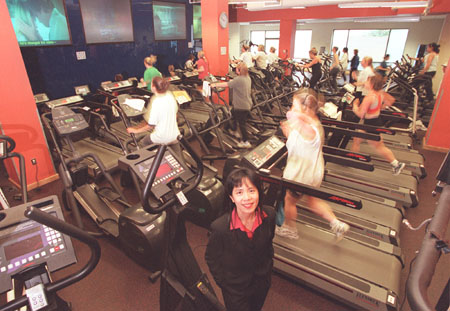Alum study extols exercise
Physical activity adds years to life

After tracking the health of Harvard alumni for 41 years, researchers offer this advice for a longer life: exercise, exercise, exercise, and quit smoking.
It’s not new advice, but the researchers have found that heeding it can add almost four years to your life.
“And it’s never too late to start.” says I-Min Lee, a Harvard Medical School epidemiologist who runs the study. “Even among those 75-84 years old, exercising and quitting smoking added almost two years. Some alums gripe that the extra years they gain would all be spent exercising. But it’s not just adding years, it’s increasing the quality of those years. You don’t have to do intensive jogging, calisthenics, and weight lifting. Brisk walking, golf, tennis, gardening, and swimming can give you the benefit of extra years.”
The College Alumni Health Study began in 1960, and is one of the largest, longest investigations of healthy people. In 1960, Ralph Paffenbarger of the Harvard School of Public Health began tracking 39,150 members of the Harvard College classes of 1920-1954, as well as alums from the University of Pennsylvania classes of 1932-44. About 25,000 have survived, 14,000 of them in the Harvard group.
Back in 1958, Paffenbarger recalls, “there was no evidence that exercise had any influence on heart disease. The famous cardiologist Paul Dudley White believed that cycling and walking decreased the risk of heart disease. However, when we found that active men experienced less heart disease and strokes than inactive men, people, including many physicians, were skeptical. They argued that exercise just influenced more important factors like weight and blood pressure. But by the 1970s, we were able to show that energy expenditure is independent of diet, weight, and high blood pressure. Men who exercised regularly had less risk of death from heart disease and stroke whether they were obese or not.”
In 1998, the Harvard study concluded that a brisk, hour-long walk five days a week cuts the risk of having a stroke almost in half. Even walking 30 minutes a day, 5 days a week drops the risk by 24 percent.
Federal health agencies agreed. In 1995, the U.S. Surgeon General recommended that everyone get at least 30 minutes of exercise a day.
Taken together, a number of studies in the past 10 years conclude that physical activity reduces the risk of heart disease, diabetes, colon cancer, and breast cancer. Evidence exists that it may also improve cognitive functioning and resistance to disease, thereby decreasing the likelihood of entering a nursing home. Inactivity is now considered an independent risk factor for a shorter life along with smoking, high blood pressure, and high cholesterol.
“We were surprised that exercise provides such a wide range of benefits,” Lee says, “including reducing the risk of the three biggest killers of Americans – heart disease, cancer, and stroke. And you don’t have to graduate from Harvard to get these benefits.”
Walking away the risks
The Harvard part of the study includes men only. Some women participate in the University of Pennsylvania group, but they are relatively few in number. Nevertheless, Lee points out, many other studies prove that women get the same benefits from physical activity as men. Postmenopausal women who exercise for about 30 minutes each day cut their risk of breast cancer in half compared with those who stay sedentary.
To make things easier for couch potatoes who dread starting an exercise program, the alumni study shows you can obtain the same benefit by breaking up a 30-minute session into two 15-minute parts. “Physical activity doesn’t have to be arduously long to be beneficial,” Lee notes. “It’s the total amount of energy expended that’s important.”
The Surgeon General’s recommendation of moderate-intensity activity for 30 minutes a day most days of the week generates an energy expenditure of about 1,000 calories a week. Men 60 and older who smoke, have high blood pressure, and diabetes can still cut their risk of heart disease about 20 percent by burning 1,000 calories a week, according to the Harvard study.
Physical activity also helps women who smoke, are overweight, or have high cholesterol to avoid heart disease. The more exercise the better, but even walking an hour a week is associated with some reduction of risk. It’s best to stride 3 or 4 mph, that is, a pace that works up a sweat, but even a more leisurely pace helps women 45 years and older.
Tracking varsity athletes reveals that the protective effect of strenuous exercise tends to disappear if not maintained. To hold on to their advantage, athletes must keep physically active in their middle and older years. “Sedentary students who took up an active lifestyle were at lower heart attack risk than former varsity players who gave up or reduced their physical activity in middle age,” Lee notes.
Harvard survivors of the alum study now average 78 years old, are an average of 5 feet 10 inches, and weigh an average of 175 pounds. That’s about right; ideal weight for a 5-foot-10-inch man or woman is 174 pounds.
That weight-height proportion gives the alums a body mass index of 25.7. The study found that men with the lowest death rate were those boasting a body mass index of less than 25. Body mass index is calculated by dividing your weight in kilograms (pounds multiplied by 0.45) by height in meters (inches multiplied by 0.025) squared.
Harvard alums expend an average of 1,800 calories a week, mostly by walking, playing tennis, calisthenics and home exercises, gardening, and swimming. Walkers average 6.5 miles a week. About 5 percent of the alums of both schools smoke today compared with more than 50 percent in the 1960s.
Wine and candy
Paffenbarger, himself, started running when his study began showing its positive effects on heart disease. “I ran the Boston Marathon 20 times,” he says. Heart bypass surgery has now slowed him down, but at age 78 Paffenbarger still walks two to three miles a day along the hilly roads of Berkeley, Calif.
Lee, a native of Malaysia and a graduate of the Harvard School of Public Health, also admits that she never exercised before working on this study. “The findings brought me to my senses,” she says. “I didn’t like exercising at first. Now, at age 41, I walk, run, Rollerblade, and lift some weights, and I enjoy it.”
If she could address the students, parents, and alums who will attend the June 7 Commencement ceremonies at Harvard, Lee would tell them: “It’s never too late to begin exercising and to extend and improve your life. If you smoke, you should stop, and you should maintain a healthy weight.”
An active, healthy life doesn’t exclude alcohol. Many studies show that a drink or two a day of wine, beer, or whiskey reduces a person’s risk of heart attacks. However, no one advises nondrinkers to start drinking alcohol.
And a healthy diet can be sweetened with candy. Contrary to the conventional belief that it must be bad for you, the Harvard study finds that men who eat candy live longer, on average, than those who don’t eat it. Men who indulged their sweet tooth one to three times a month fared best, but any reasonable level is better than no candy at all.
“Candy causes dental (cavities) and can lead to weight gain if not balanced with physical activity,” Lee cautions. “However, chocolate contains the antioxidant phenol which is also found in heart-healthy red wine. It has also been speculated that cacao, from which chocolate is made, inhibits the action of low-density (bad) cholesterol and can enhance immune-system function. If so, that would lead to a reduced risk of heart disease and cancer.”
A physically active life, then, can be both longer and sweeter.




